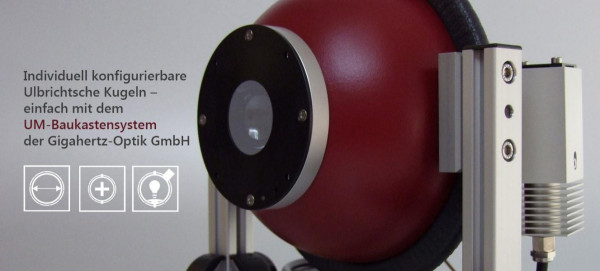
Modular Integrating Spheres from Gigahertz Optik GmbHIntegrating Spheres (UM)* are an important component of many optical systems. They are used as detectors for measuring all kinds of divergent light sources. When used as a light source, they provide uniform light fields with diffuse radiation. In the photometric analysis of materials they enable the measurement of reflection, transmission, absorption, photoluminescence, etc. In addition to an extensive range of standard products, Gigahertz Optik GmbH offers individually configured integrating spheres. These bespoke integrating spheres permit many unique features including the tailored positioning, design and number of ports. This paper describes UM-modular system concept, including the various sphere assemblies and accessories that enable complete sphere systems to be built. Configuring your own modular integrating sphere is described in 10 easy steps. Some example configurations illustrate the range of possibilities with the UM-modular system. * Also known as Ulbricht spheres after the engineer Richard Ulbricht (1849-1923) credited with its invention. The M stands for Modular Concept. |
Example integrating sphere set-up with the UM-modular integrating sphere construction kit
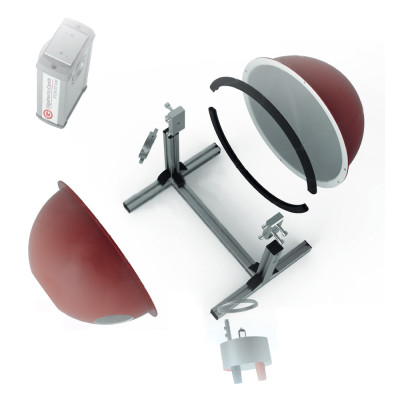
Design criteria for integrating spheres
The UM-modular system offers the possibility of customized spheres for common application areas.
Integrating Sphere Detectors
 | Integrating Sphere Detectors not only measure the luminous flux and radiant power of lamps, LEDs and luminaires, but also of lasers, laser diodes, optical fibers and endoscopes. |

Principle design criteria for integrating sphere detectors
See our Integrating sphere detectors
Integrating sphere light sources
 | Integrating sphere light sources, often referred to as Uniform Light Sources, offer diffuse radiation with high uniformity of luminance or radiance. Typical applications include white pixel balancing of digital camera systems, characterization of CMOS and CCD sensors, hyperspectral systems, measuring scattered light (veiling glare), calibration of measuring instruments for luminance and spectral radiance, target illumination. |

Design criteria for Integrating sphere light sources (Uniform Light Sources)
See our Integrating sphere light sources
Integrating Spheres for Material Characterization
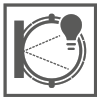 | Integrating Spheres for measuring photometric material properties such as reflection, transmission, absorption, photoluminescence. |

Principle design criteria for integrating spheres for the determination of optical material characteristics
See our Integrating Spheres for Material Characterization
The modules of the UM-modular system
The fundamental concept of the modular integrating sphere system is to provide a range of standard modules that can be configured to meet the requirements of individual applications. The base sphere and sphere assemblies are inextricably linked. Complete integrating sphere based measurement systems are offered by the wide range of available accessories which can be attached to the corresponding port frame.
Configuration and Service
The configuration of the individual integrating sphere with the selected accessories is carried out at Gigahertz-Optik GmbH. In addition to its standard modules Gigahertz-Optik GmbH offers the manufacture of custom assemblies. The Gigahertz-Optik GmbH range also includes complete integrating sphere systems and the services of our calibration laboratory for optical radiation measurement technology.
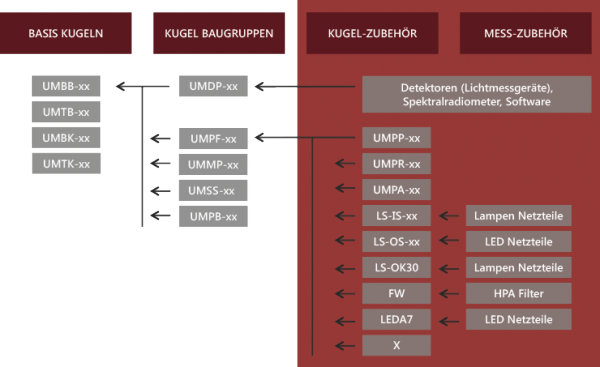
Modules and accessories
An overview of our modular UM product portfolio is given at the end of the page. Please do not hesitate to contact us with any questions. We look forward to assisting you
10 Steps to individually configured integrating spheres
There follows ten simple steps to help you create your own integrating sphere. The experienced Gigahertz team is always happy to help with any questions regarding your particular requirements. We look forward to assisting you configure your individual integrating sphere.
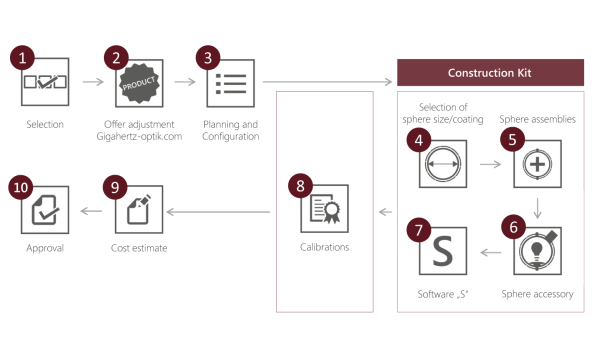
1. What type of application is the integrating sphere to be used for?
 | a) ISD integrating sphere detectors b) ISM integrating spheres for material assessment (measurement of reflection, transmission, absorption, photoluminescence, etc.) c) ISS Integrating Sphere Light Sources (luminance and radiance standards, uniform light sources) |
2. Is there a standard product available?
 | First, take a look at our standard range of preconfigured integrating spheres including: integrating sphere detectors (ISD); integrating sphere light sources (ISS); and integrating spheres for material characterization. In addition to these three main application types we offer the UP series. The housings of these integrating spheres are made from precision CNC machined aluminum blocks. This results in the highest precision of spherical shape and geometry and position of the port openings. Selecting a standard product will save you time and money. Our sales team will be happy to assist in the search and selection.
|
3. Planning and configuration
 | If you have not found a suitable standard integrating sphere type or system for your application, this is the point to start planning the sphere configuration. You’ll need to determine which sphere accessories and metrology accessories from Gigahertz-Optik’s range will be required. This is a good time to consult our sales team to assist you configure your custom integrating sphere. |

4. Selection of sphere size and coating
 | As a guideline, the following should be considered:
|
5. Configuration planning of the base sphere and sphere assemblies
 | A hand sketch of the required sphere configuration is an effective planning tool. A three-panel sketch of the base sphere is recommended showing front, side and top views. This should show any flanges, auxiliary frame or base components in the desired orientation. It is important to ensure that any sphere assemblies and accessories are shown in proportion to the size of the sphere. The presentation of all the required components serves as a reliable template from which a Bill of Materials, BOM, can be produced for manufacturing purposes. Familiarize yourself with the design criteria for integrating spheres - refer to the information portal of our website: Basics of light measurement. |

6. Sphere and metrology modules complete the system
 | Complete measurement systems can be assembled using the customized sphere in conjunction with additional products from Gigahertz-Optik’s extensive metrology range as well as third party components. In this case, please discus your proposed application so that a technical specification can be drawn up.
|
7. "S-Series" Software from Gigahertz Optik GmbH
 | Gigahertz-Optik GmbH offers the versatile “S-Series” software for use with the external modules of integrating sphere systems. In addition to many standard routines, “S-Series” software provides the option to add additional functions and to integrate evaluation modules. The S-SDK Software Development Kits enable full remote control from the user's software of sphere accessories, data acquisition systems, variable apertures, power supplies, etc.
|
8. Discussion and definition of required calibrations
 | The optical radiation calibration laboratory of Gigahertz-Optik GmbH offers traceable calibrations for integrating sphere systems. Possible calibrations include:
|
9. Assembly drawing and cost estimate
 | A cost estimate including all the required components and services is issued based on the created sketches and discussed system configuration. Any change requests can be discussed based on the cost estimate.
|
10. Approval and quoting
 | Once the cost estimate and the sphere configuration are finalized, Gigahertz-Optik GmbH will issue a binding offer. A new part number is created for the entire custom sphere configuration in order to simplify the ordering process and to reduce costs where possible.
|

See our Integrating Sphere Construction Kit
Modules and accessories
| Base Spheres | ||
| UMBB | base spheres with flange. Barium sulfate coating. | Various diameters |
| UMTB | base spheres with stand or auxiliary frame.Barium sulfate coating. | Various diameters |
| UMBK | base spheres with flange.Synthetic ODM98 coating. | Various diameters |
| UMTK | base spheres with stand or auxiliary frame. Synthetic ODM98 coating. | Various diameters |
| Sphere Assemblies | ||
| UMPF | Port frames with circular V-groove for attaching accessories | 0.5" to 10" clear aperture |
| UMMP | port openings without port frame or knife edge | XXX |
| UMDP | port mounts | for detectors and spectroradiometer |
| UMPB | baffles | for shading two or more ports, samples and sphere center |
| UMSS | frames, stands and sockets | for pole mounting of the sphere |
| Sphere Accessories | ||
| UMPP | plugs | for use with port frames for closing ports |
| UMPR | reducers for use with port frames | with straight or knife edge |
| UMPA | port adapters | for use with auxiliary lamps, Microbenches, fiber-optic connection |
| UMSH | sample holder | mount and electrical connection of test samples or lamp adapters |
| UMLA | lamp adapters | for different lamp base types E14, E27, etc. |
| LS-IS | internal lamp assembly | for halogen lamps up to 100W |
| LS-OS | external lamp assembly | for halogen and LED lamps |
| LS-OK | external lamp assembly | for reflector halogen lamps, optional filter holder, variable aperture |
| Measurement Accessories | ||
| PD-11 | Photodiode detectors | Si, InGaAs, |
| VL-11 | Photometric detectors | Precision V(λ) match |
| TD-11 | Temperature controlled detectors | Si, InGaAs, V(λ) |
| X1-RM | Optometer for detectors | For 19” Rack mounting |
| P-2000 | Optometer for detectors | Benchtop meter for two detectors. RS232 & IEEE488 |
| P-9801 | Optometer for detectors | Benchtop meter for eight detectors. RS232 & IEEE488 |
| BTS256-LED | Spectroradiometer with BiTec Sensor | Bayonet connection to integrating sphere |
| BTS2048-VL | Spectroradiometer with BiTec Sensor | High resolution, wide dynamic range, I/O trigger for pulse and CW measurements, diffuser entrance optic |
| BTS2048-VL-F | Spectroradiometer with BiTec Sensor | High resolution, wide dynamic range, I/O trigger for pulse and CW measurements, fibre optic input |
| LEDA7 | LED measurement adapter | Thermoelectric control of LED junction temperature. Four wire holders for SMD LEDs and on-board LEDs up to 70mm diameter. Remote control interface. |
| S | Software | Application software for measuring instruments and accessories |
| S-SDK | Software | Development tool for integration into user written software |